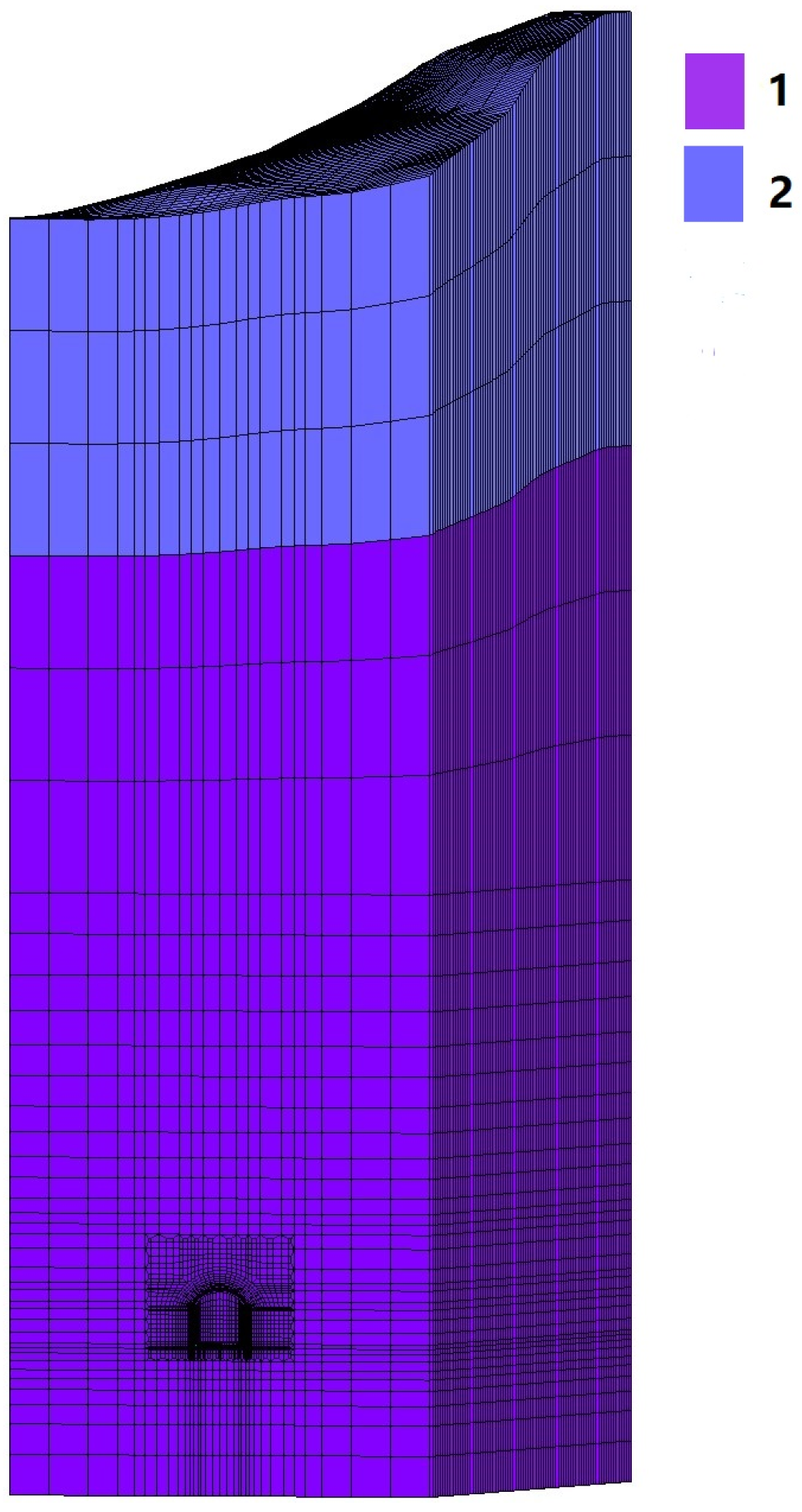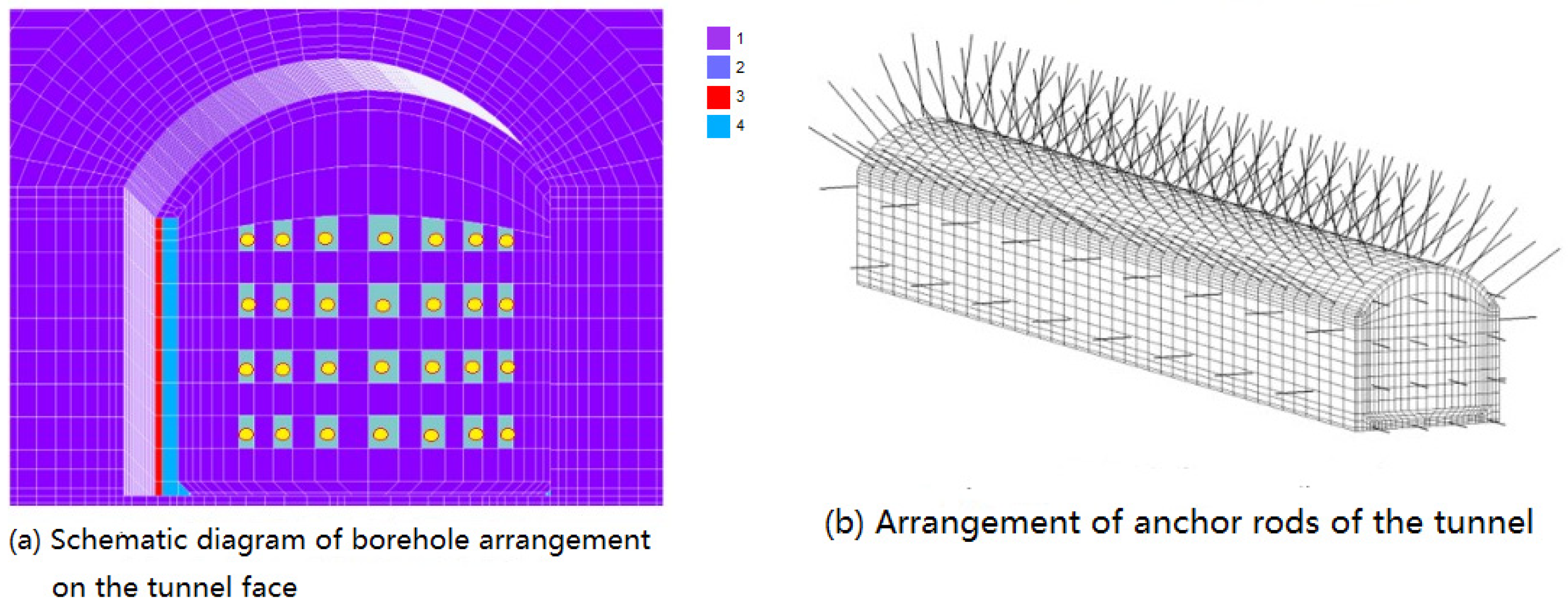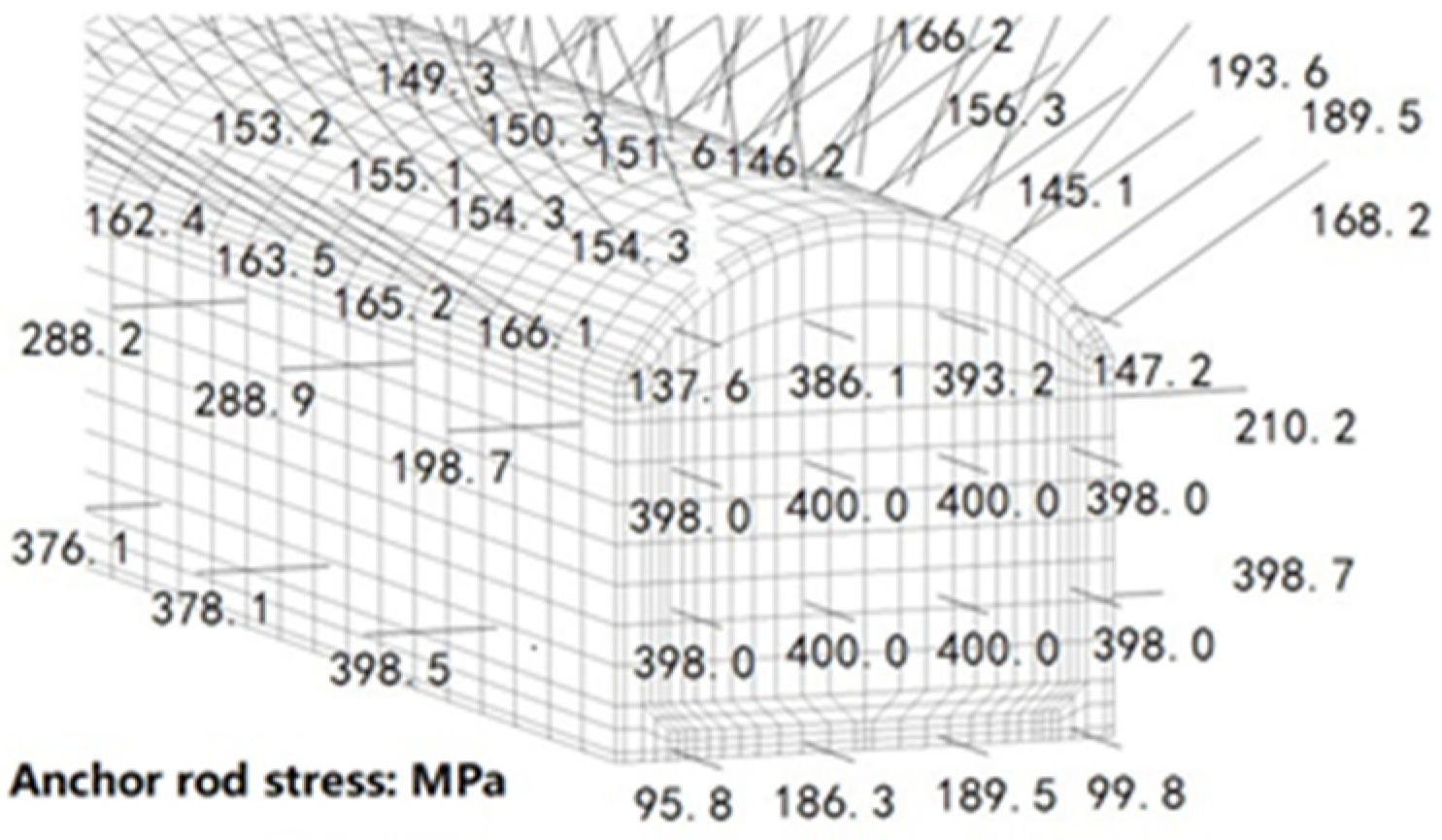Numerical Simulation Analysis Method for Rockburst Control in Deeply Buried Caverns
Abstract
:1. Introduction
2. Mechanism and Control Measures of Rockburst
2.1. Rockburst Mechanism and Evaluation Methods
2.2. Control and Prevention Measures for Rockburst
3. Numerical Analysis Method for Rockburst Control with Anchor Rod Reinforcement
3.1. Mathematical Model of Implicit Anchor Rod Element
3.2. Analysis of the Rockburst Control Effect of Anchor Rod Support
4. Numerical Analysis Method for Relieving Rockburst through Borehole Stress Release
4.1. Mathematical Model of the Implicit Hole Element
4.2. Energy Release Calculation of the Borehole Element
5. Analysis of the Rockburst Control Effect in Deep Tunnel Excavation
6. Conclusions
Author Contributions
Funding
Institutional Review Board Statement
Informed Consent Statement
Data Availability Statement
Acknowledgments
Conflicts of Interest
References
- Sakhno, I.; Sakhno, S.; Vovna, O. Assesing a risk of roof fall in the development mine workings in the process of longwall coal mining in terms of Ukrainian mines. Min. Miner. Depos. 2020, 14, 15. [Google Scholar] [CrossRef]
- Terzaghi, K. Introduction to tunnel geology. In Rock Tunnelling with Steel Supports; Commercial Shearing & Stamping Company: Youngstown, OH, USA, 1946; pp. 17–99. [Google Scholar]
- Obert, L.; Duvall, W.I. Rock Mechanics and the Design of Structures in Rock; Wiley: Hoboken, NJ, USA, 1967. [Google Scholar]
- Hedley, D.G.F. Rockburst Handbook for Ontario Hardrock Mines; Energy, Mines and Resources: Ottawa, ON, Canada, 1992. [Google Scholar]
- Kaiser, P.K.; McCreath, D.R.; Tannant, D.D. Canadian Rockburst Support Handbook; Geomechanics Research Center: Sudbury, ON, Canada, 1996. [Google Scholar]
- Wang, J.A.; Park, H.D. Comprehensive prediction of rockburst based on analysis of strain energy in rocks. Tunn. Undergr. Space Technol. 2001, 16, 49–57. [Google Scholar] [CrossRef]
- Zhou, J.; Li, X.B.; Mitri, H.S. A critical survey of empirical methods for evaluating rockburst potential. In Proceedings of the 15th IACMAG, Wuhan, China, 19–23 October 2017; pp. 18–22. [Google Scholar]
- Dietz, M.; Oremek, G.M.; Groneberg, D.A.; Bendels, M.H.K. What is a rock burst? Zentralblatt Arbeitsmedizin Arbeitsschutz Ergon. 2018, 68, 45–49. [Google Scholar] [CrossRef]
- Kaiser, P.K.; Diederichs, M.S.; Martin, C.D.; Sharp, J.; Steiner, W. Underground works in hard rock tunnelling and mining. In Proceedings of the ISRM International Symposium, Melbourne, Australia, 19–24 November 2000; p. ISRM-IS. [Google Scholar]
- Tang, B. Rockburst Control Using Destress Blasting. Ph.D. Thesis, McGill University, Montreal, QC, Canada, 2000. [Google Scholar]
- Fan, P.X.; Wang, M.Y.; Yue, S.L.; Shi, C.Y. Review on the Evolution Law, Mechanics and Prevention of Strain Rockburst. J. Wuhan Univ. Technol. 2013, 35, 96–101. [Google Scholar]
- Guo, L.; Li, X.B.; Yan, X.M. Research Progress and Development Trend of Rockburst. Min. Technol. 2006, 2006, 16–20. [Google Scholar] [CrossRef]
- Wang, J.M.; Wu, X.X.; Zeng, X.H.; Yan, P. Active Prevention of Rock Burst by Blasting Technology in Jinping Auxiliary Tunnel. J. Yangtze River Sci. Res. Inst. 2014, 31, 114–119. [Google Scholar] [CrossRef]
- Yan, P.; Chen, X.R.; Shan, Z.G.; Zhou, Y. Study of rock-burst prevention measures based on controlling the super shear stress. Rock Soil Mech. 2008, 29, 453–458. [Google Scholar] [CrossRef]
- Lu, W.B.; Chen, M.; Yan, P. Study on Vibration Characteristics of Surrounding Rock Induced by Tunnel Excavation under High In-situ Stress. Chin. J. Rock Mech. Eng. 2007, 26, 3329–3334. [Google Scholar]
- Xie, W.Q. Mechanism of Rockburst in Underground Works and Countermeasures. Mod. Tunn. Technol. 2008, 45, 8–13. [Google Scholar]
- Li, Z.L.; Tang, H.Y. Evaluation of Rockburst Proneness by Elastic Strain Energy Indices. Min. Res. Dev. 2005, 25, 16–19. [Google Scholar] [CrossRef]
- Zhang, X.J. Pattern and damage evolution of unloading rockburst for high-stress hard rock. Rock Soil Mech. 2012, 33, 3554–3560. [Google Scholar] [CrossRef]
- Feng, X.T.; Chen, B.R.; Ming, H.J. Evolution Law and Mechanism of Rockbursts in Deep Tunnels: Immediate Rockburst. Chin. J. Rock Mech. Eng. 2012, 31, 433–444. [Google Scholar]
- Wang, M.Y.; Fan, P.X.; Li, W.P. Mechanism of Splitting and Unloading Failure of Rock. Chin. J. Rock Mech. Eng. 2010, 29, 234–241. [Google Scholar]
- Yang, F.J.; Zhou, H.; Lu, J.J.; Zhang, C.Q. An Energy Criterion in Process of rockburst. Chin. J. Rock Mech. Eng. 2015, 34, 2706–2714. [Google Scholar] [CrossRef]
- Shemyakin, E.I.; Kurlenya, M.V.; Kulakov, G.I. Classification of Rock Bursts. J. Min. Sci. 1987, 22, 329–336. [Google Scholar] [CrossRef]
- Bai, Y.F. Study on Mechanism and Pillar Rockburst Based on Catastrophe Theory; Central South University: Changsha, China, 2009. [Google Scholar]
- Wang, Y.H.; Li, W.D.; Li, Q.G.; Xu, Y.; Tan, G.H. Method of Fuzzy Comprehensive Evaluations for Rockburst Prediction. Chin. J. Rock Mech. Eng. 1998, 17, 493–500. [Google Scholar]
- Lu, J.Y. Theory and Practice of Rock Burst Prediction. J. Min. Strat. Control Eng. 1998, 32, 26–29. [Google Scholar]
- GB50487-2008; Code for Engineering Geological Investigation of Water Resources and Hydropower. China Astronautics Publishing House: Beijing, China, 2008.
- Xie, H.P. Damage Mechanics of Rock and Concrete; China University of Mining and Technology Press: Beijing, China, 1990. [Google Scholar]
- Cook, N.G.W. The Failure of Rock. Int. J. Rock Mech. Min. Sci. 1965, 2, 389–403. [Google Scholar] [CrossRef]
- Kidybinski, A. Bursting Liability Indices of Coal. Int. J. Rock Mech. Min. Sci. 1981, 18, 295–304. [Google Scholar] [CrossRef]
- Tang, B.Q.; Cao, P. Establishing the energy index of rock burst from the perspective of the full stress-strain curve. Nonferrous Met. Sci. Eng. 1995, 9, 15–20. [Google Scholar]
- Lu, S.L.; Tang, L.; Yang, X.A. Anchor Rod Anchoring and Anchoring Technology; China Coal Industry Publishing House: Beijing, China, 1998. [Google Scholar]
- Xiao, M. Three-Dimensional Elastoplastic Finite Element Analysis of Implicit Anchor Rod Column Elements in Underground Caverns. Chin. J. Geotech. Eng. 1992, 14, 19–26. [Google Scholar]
- Xiao, M.; Ren, J.Q.; Zhao, B.X.; Chen, C.; Chen, S.J. Numerical Simulation Analysis Method of the Surrounding Rock and Support Bearing Capacity in Underground Cavern. Energies 2022, 15, 7788. [Google Scholar] [CrossRef]
- Xu, Z.L. A Concise Tutorial on Elasticity; China Higher Education Press: Beijing, China, 2018. [Google Scholar]








| Elastic Modulus E | Deformation Modulus E0 | Bulk Density γ |
|---|---|---|
| 15–20 GPa | 8~10 GPa | 2.65~2.7 kN/m3 |
| compressive strength Rb | friction coefficient f | cohesion C |
| 60~70 MPa | 0.95~1.0 | 0.65~0.7 MPa |
| Poisson’s ratio μ | Kz = 1.2 | Ky = 1.9 |
| 0.22~0.23 | Kx = 1.5 | Kxy = 0.132 |
Disclaimer/Publisher’s Note: The statements, opinions and data contained in all publications are solely those of the individual author(s) and contributor(s) and not of MDPI and/or the editor(s). MDPI and/or the editor(s) disclaim responsibility for any injury to people or property resulting from any ideas, methods, instructions or products referred to in the content. |
© 2023 by the authors. Licensee MDPI, Basel, Switzerland. This article is an open access article distributed under the terms and conditions of the Creative Commons Attribution (CC BY) license (https://creativecommons.org/licenses/by/4.0/).
Share and Cite
Zhan, S.; Liu, Y.; Xiao, M.; Du, X.; Chen, Y.; Xing, T.; Kong, C. Numerical Simulation Analysis Method for Rockburst Control in Deeply Buried Caverns. Appl. Sci. 2023, 13, 11197. https://doi.org/10.3390/app132011197
Zhan S, Liu Y, Xiao M, Du X, Chen Y, Xing T, Kong C. Numerical Simulation Analysis Method for Rockburst Control in Deeply Buried Caverns. Applied Sciences. 2023; 13(20):11197. https://doi.org/10.3390/app132011197
Chicago/Turabian StyleZhan, Shuangqiao, Yuhang Liu, Ming Xiao, Xingwu Du, Yuncai Chen, Tian Xing, and Ci Kong. 2023. "Numerical Simulation Analysis Method for Rockburst Control in Deeply Buried Caverns" Applied Sciences 13, no. 20: 11197. https://doi.org/10.3390/app132011197




